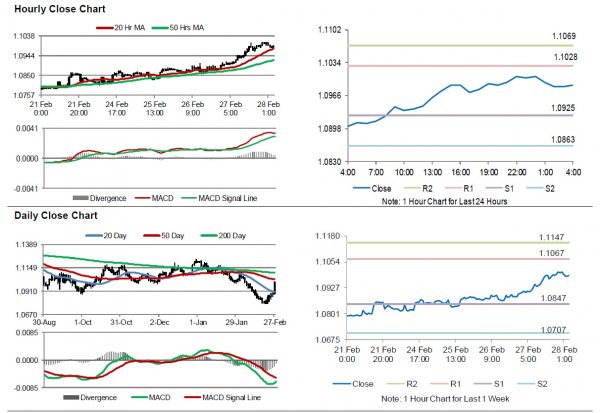For the 24 hours to 23:00 GMT, the EUR rose 1.10% against the USD and closed at 1.1002.
On the data front, Euro-zone’s consumer confidence rose to -6.6 in February, in line with market expectations and compared to a revised level of -8.1 in the previous month. Additionally, the business climate indicator unexpectedly climbed to -0.04 in February, confounding market forecast for a fall to a level of -0.28 and compared to a revised reading of -0.19 in the prior month. Moreover, the economic sentiment indicator advanced to 103.5 in February, marking its highest level in nine months and surpassing market consensus for a rise to 102.8. In the previous, the index had recorded a revised reading of 102.6. Meanwhile, M3 money supply rose 5.2% on an annual basis in January, undershooting market expectations for a rise of 5.5% and compared to a revised growth of 4.9% in the prior month.
In the US, annualised gross domestic product (GDP) advanced by 2.1% on a quarterly basis in 4Q19, in line with market expectations. The preliminary figures had also indicated an advance of 2.1%. Additionally, pending home sales climbed 5.2% on a monthly basis in January, compared to a revised fall of 4.3% in the prior month. Moreover, the Kansas City Fed manufacturing index unexpectedly rose to a level of 5.0 in February, compared to a level of -1.0 in the prior month. Further, flash durable goods orders fell 0.2% on a monthly basis in the US, less than market forecast and compared to a revised rise of 2.9% in the previous month. On the other hand, seasonally adjusted initial jobless claims rose to a level of 219.0K in the week ended 21 February 2020. In the prior week, initial jobless claims had registered a revised level of 211.0K.
In the Asian session, at GMT0400, the pair is trading at 1.0988, with the EUR trading 0.13% lower against the USD from yesterday’s close.
The pair is expected to find support at 1.0925, and a fall through could take it to the next support level of 1.0863. The pair is expected to find its first resistance at 1.1028, and a rise through could take it to the next resistance level of 1.1069.
In absence of crucial macroeconomic releases in the Euro-zone today, investors would keep a close watch on Germany’s unemployment rate and consumer price index, both for February as well as current account balance for December, slated to release in a few hours. Later in the day, the US personal income, personal spending, visible trade balance, all for January, followed by the Chicago Purchasing Managers’ Index and the Michigan consumer sentiment index, both for February, will keep investors on their toes.
The currency pair is showing convergence with its 20 Hr moving average and trading above its 50 Hr moving average.













